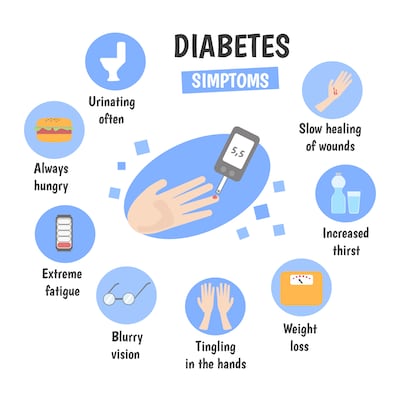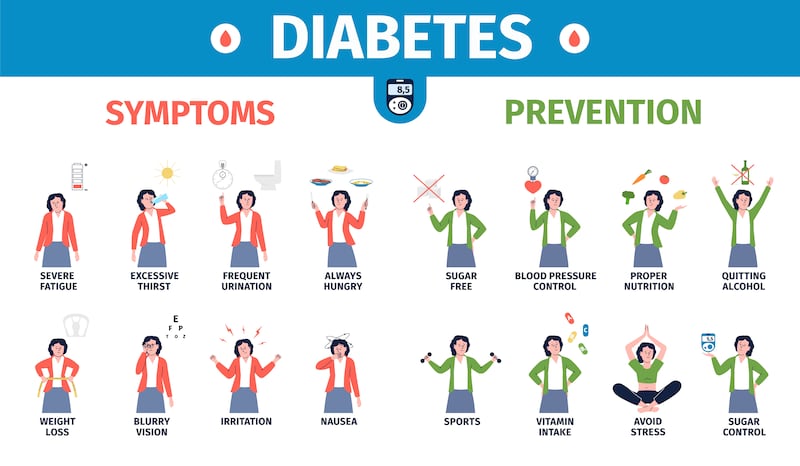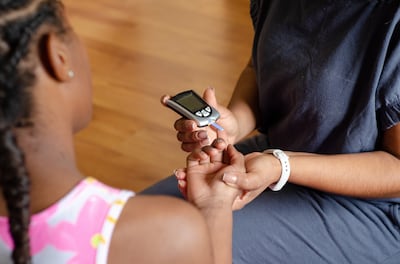What is it and who gets it?
Diabetes is a chronic condition which occurs when not enough of or no insulin is produced in the pancreas. Insulin is the hormone which helps cells produce energy from glucose (sugar) in digested food. Without insulin cells can’t access the glucose which builds up in the bloodstream, instead causing multiple problems in the body.
There are three main types of diabetes.
Diabetes type 1 – which accounts for 10 per cent of all diabetes cases – is an autoimmune disease in which insulin production stops completely. It is commonly diagnosed in childhood but also in adulthood.
Diabetes type 2, which is often diagnosed later in life but increasingly in younger people, occurs when not enough insulin is produced to allow cells to take up glucose from the blood.
READ MORE
Gestational diabetes is a form of diabetes which affects about 7,000 pregnant women in Ireland and women who experience gestational diabetes have a 50 per cent higher risk of developing type 2 diabetes later in life.
There are approximately 300,000 people with diabetes in Ireland. It is estimated that one in 10 adults in Ireland aged 50 and over has type 2 diabetes, which rises to one in six in those aged 80 and over. And while high blood pressure, high cholesterol, weight gain around the stomach and low levels of physical activity increase the risk of type 2 diabetes, about 15 per cent of those with type 2 diabetes are fit and healthy but genetically predisposed to the condition.

What are the symptoms of diabetes and how is it diagnosed?
Excessive thirst, frequent passing of urine, tiredness and weight loss are early symptoms of diabetes. Diabetes Ireland uses the TEST acronym to improve awareness of symptoms of Diabetes 1 among parents so that the disease can be picked up before complications arise.
- T for thirst,
- E for energy reduction,
- S for sudden weight change,
- T for toilet trips increased.
Type 2 Diabetes builds up more slowly and many people over 50 have the condition without knowing it. “The key to managing people with type 2 diabetes is to diagnose them before complications arise,” says Dr Velma Harkins, GP in Banagher, Co Offaly and former national GP clinical lead for diabetes. “Anyone who has risk factors, including being overweight, a family history of type 2 diabetes, a sedentary lifestyle or a past history of gestational diabetes should be tested for diabetes once a year by their GP.”
A fasting blood glucose test is the standard diagnostic test for type 2 diabetes. The haemoglobin A1c (HbA1c) tests the amount of blood sugar (glucose) in your red blood cells over the past three months and can diagnose type 2 diabetes and pre-diabetes. You can do an online diabetes risk assessment on the International Diabetes Foundation website.

What are the complications of diabetes?
The complications can be divided into those impacting the micro-vascular system which is the blood supply to the small blood vessels (capillaries) in the feet (with the risk of foot ulcers), the eyes (with the risk of blindness due to diabetes retinopathy) and the kidneys (with the risk of renal failure).
Complications of the macro-vascular system involving the larger blood vessels (arteries and veins) result in stroke or heart disease. A build-up of sugar in the liver is also one of the most common causes of long-term liver damage.
What treatments are available now and how do they compare to past treatments?
Type 1 diabetes is managed by replacing the body’s insulin either with multiple daily insulin injections or by using an insulin pump. People with type 1 diabetes need to check their blood glucose levels regularly either by finger prick blood test or via a continuous glucose monitoring device in the upper arm or abdomen. The introduction of insulin pumps and hybrid closed loop pumps (which are linked to the continuous glucose monitoring device) in the last 10 years or so have made it easier for patients to manage insulin levels and led to an improved quality of life.
However, Diabetes Ireland says that there is uneven access for patients to these pumps throughout Ireland. “More than 50 per cent of children are using insulin pumps but older children and adults can be waiting a year for these devices,” says Dr Kate Gajewsha, clinical manager for advocacy and research at Diabetes Ireland.
Dietary and exercise programmes are the first treatment approach for people diagnosed with type 2 diabetes before medications are considered.
There are several different drugs used to treat diabetes type 2. Some stimulate the pancreas to make more insulin, some reduce the amount of glucose produced in the liver, some increase the sensitivity of the body tissues to insulin and some slow down the absorption of glucose from the digestive system.
“Some people who change their diets and lose weight may still need medications,” says Prof Derek O’Keeffe, endocrinologist at University Hospital Galway and HSE clinical lead for diabetes in Ireland. Metformin is the more commonly prescribed medication for type 2 diabetes. “We will add in other medications such as SGLT2 inhibitors and GLP-1 agonists either in pill or via injections. Most people with type 2 diabetes will end up on insulin,” says Prof O’Keeffe.

Have there been any breakthroughs in understanding the condition recently?
The arrival on the market of the new so-called GLP-1 agonists drugs have created quite a storm. Branded medications such as Ozempic (and its sister medication Wegovy, which isn’t yet available in Ireland) have been found to not only reduce blood sugar levels but also to provoke weight loss. “Very few medicines have such an impact on society and the company which makes these drugs can’t make them fast enough because they are being used for weight loss. Recent studies have also found that they solve kidney problems and there are some suggestions now that they reduce addictions to alcohol and drugs,” says Prof O’Keeffe.
While these drugs are only licensed for diabetes treatment in Ireland, there is huge demand for them as weight loss medications. Some experts argue that if patients take these new – and expensive – drugs for weight loss there could be a knock-on effect of reducing cases of type 2 diabetes.
Another recent breakthrough from consultant endocrinologist Prof Fidelma Dunne and researchers at the University of Galway is the discovery that Metaformin, a medicine used to lower blood sugar levels, is an effective treatment for gestational diabetes. Traditionally gestational diabetes is managed through diet and exercise, with insulin only given if blood sugar levels remain high due to the risks of excess weight gain for mothers, higher Caesarean birth rates and intensive care needs for newborn babies. Now this new study confirms that Metaformin can be used instead of insulin treatment.
What are the services like for people with diabetes in Ireland?
People with type 1 diabetes are advised to have twice yearly check-ups at endocrinology outpatients’ clinics in hospitals. Yet a 2022 survey by Diabetes Ireland found that one in three people with type 1 diabetes had only one appointment that year and one in 10 didn’t have any appointment at all. “Children are receiving the care they need but many adults with type 1 diabetes are waiting too long for appointments,” says Dr Gajewsha.
As part of the Slaintecare model the care of people with type 2 diabetes is moving from hospitals into community healthcare hubs with consultant-led multidisciplinary teams with clinical nurse specialists, podiatrists and dietitians. However, while this model of care is widely accepted many community hubs don’t have full teams in place or dedicated spaces to see patients.
The Diabetes Ireland 2022 survey found that one in five patients with type 2 diabetes had only one appointment that year, with one in five not having any appointment at all. “The move from hospital care to community care is a great initiative and we will see the benefit in a few years, but currently about two in five patients with type 2 diabetes, who don’t have a GP or medical cards, prefer to get their care in hospitals because it is free,” says Dr Gajewsha.
Also, the recruitment of multidisciplinary teams in community care has reduced staffing in some hospitals, according to Dr Gajewsha.
Prof O’Keeffe acknowledges that there is a shortage of staff at community hubs in some parts of Ireland, which he hopes will be addressed by increased numbers of students studying podiatry, dietetics and nursing.
Since 2020 GPs have also taken over the care of managing chronic diseases including type 2 diabetes.
Patients aged 12 years and over who have been diagnosed with diabetes (type 1 and type 2) will be offered free screening for diabetic retinopathy once they register with the National Screening Service Diabetic RetinaScreen programme. Currently, there isn’t a similar screening service for other complications such as foot ulcers, and kidney and liver diseases.
“Every person with diabetes should have an annual review of their feet, eyes, kidneys and heart,” says Dr Gajewsha.
What does the future hold for people with diabetes?
A recent editorial in the Lancet medical journal described diabetes as the defining disease of the 21st century. “How the health community deals with diabetes in the next two decades will shape population health and life expectancy for the next 80 years,” it said.
It is no coincidence that rising levels of type 2 diabetes happened at the same time as a shift in diets to processed and ultra-processed foods. And while the HSE runs a diabetes prevention programme with an emphasis on healthy eating, smoking cessation and exercise, some experts suggest that rising levels of type 2 diabetes will not curbed until wider aspects of our so-called obesogenic environment are tackled so that everyone can lead physically active lives with access to nutritional food on a daily basis.
“We drive. We sit in front o computers all day long. We don’t take the time to cook and we eat quickly. There are higher levels of type 2 diabetes in socially deprived areas where buying processed food is cheaper than cooking. Tackling type 2 diabetes is a very big challenge for health systems,” says Dr Gajewsha.



















